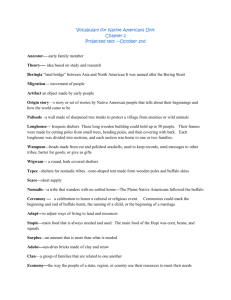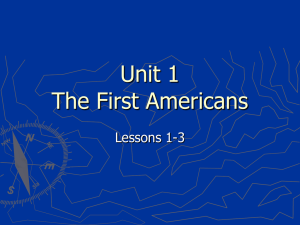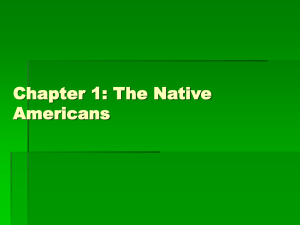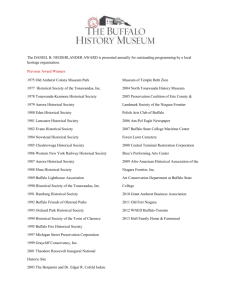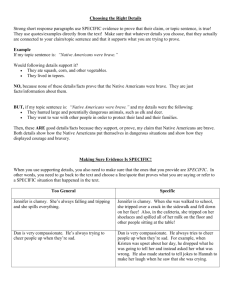Native American Cultural Regions readings
advertisement
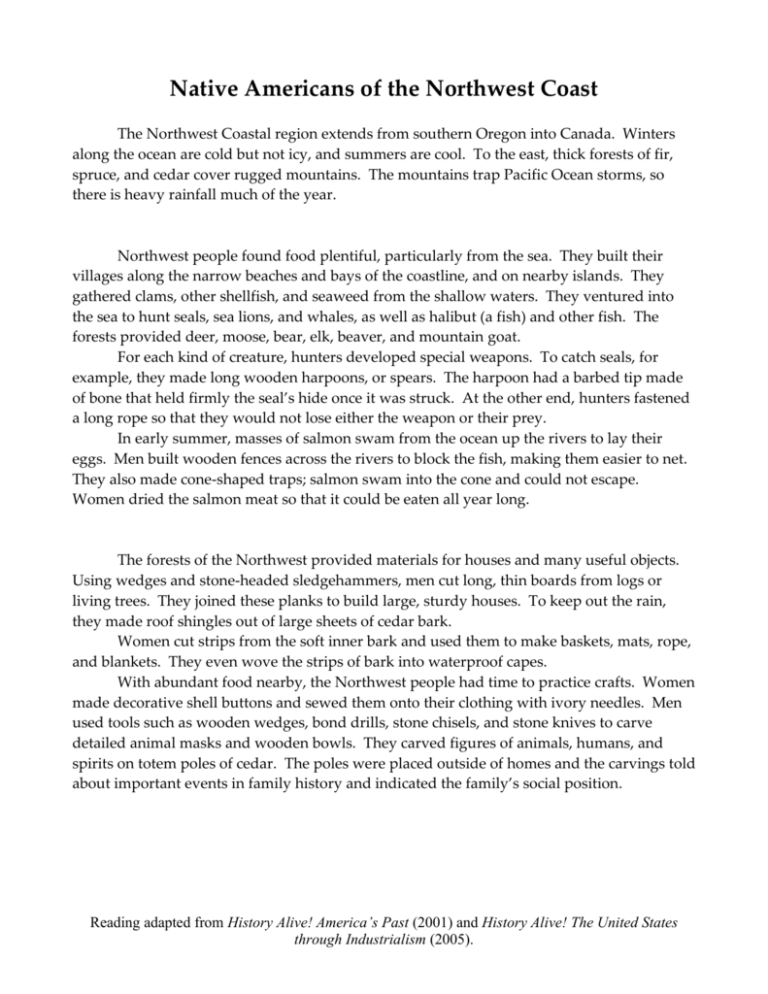
Native Americans of the Northwest Coast The Northwest Coastal region extends from southern Oregon into Canada. Winters along the ocean are cold but not icy, and summers are cool. To the east, thick forests of fir, spruce, and cedar cover rugged mountains. The mountains trap Pacific Ocean storms, so there is heavy rainfall much of the year. Northwest people found food plentiful, particularly from the sea. They built their villages along the narrow beaches and bays of the coastline, and on nearby islands. They gathered clams, other shellfish, and seaweed from the shallow waters. They ventured into the sea to hunt seals, sea lions, and whales, as well as halibut (a fish) and other fish. The forests provided deer, moose, bear, elk, beaver, and mountain goat. For each kind of creature, hunters developed special weapons. To catch seals, for example, they made long wooden harpoons, or spears. The harpoon had a barbed tip made of bone that held firmly the seal’s hide once it was struck. At the other end, hunters fastened a long rope so that they would not lose either the weapon or their prey. In early summer, masses of salmon swam from the ocean up the rivers to lay their eggs. Men built wooden fences across the rivers to block the fish, making them easier to net. They also made cone-shaped traps; salmon swam into the cone and could not escape. Women dried the salmon meat so that it could be eaten all year long. The forests of the Northwest provided materials for houses and many useful objects. Using wedges and stone-headed sledgehammers, men cut long, thin boards from logs or living trees. They joined these planks to build large, sturdy houses. To keep out the rain, they made roof shingles out of large sheets of cedar bark. Women cut strips from the soft inner bark and used them to make baskets, mats, rope, and blankets. They even wove the strips of bark into waterproof capes. With abundant food nearby, the Northwest people had time to practice crafts. Women made decorative shell buttons and sewed them onto their clothing with ivory needles. Men used tools such as wooden wedges, bond drills, stone chisels, and stone knives to carve detailed animal masks and wooden bowls. They carved figures of animals, humans, and spirits on totem poles of cedar. The poles were placed outside of homes and the carvings told about important events in family history and indicated the family’s social position. Reading adapted from History Alive! America’s Past (2001) and History Alive! The United States through Industrialism (2005). Native Americans of California The California cultural region stretches from southern Oregon through Baja California. Ocean storms bring winter rains to this region. But summers are hot and dry, particularly inland. The California region includes not only the coast, but also the coastal foothills, and inland valley, deserts, and the western side of the Sierra Nevada mountain range. Over 100 small groups made their homes in these diverse environments, more than in any other cultural region. Groups living along the coast of Northern California depended on salmon for much of their food. Farther south, coastal people relied more on shellfish. Away from the coast, groups hunted deer with bows and arrows. They set snares to trap rabbits and used nets to capture ducks. California people also gathered roots, berries, and pine nuts. Most people in the region relied on acorns from oak trees as a basic food. In the fall, women harvested the acorns, shelled them, and pounded the nuts into meal. Water was rinsed through the meal to remove its bitterness. Women cooked the meal by mixing it with water in tightly woven baskets and then dropping hot cooking stones into the mixture. As they worked, the women wore simple aprons or skirts made from grasses or other plants, or sometimes from leather strips. In colder months, they wrapped themselves in animal hides. Because the climate was mild, California people built simple homes. In forested areas, men used tools made from the antlers of deer and elk to strip large slabs of bark from redwood trees. They draped these into a cone shape to form a house. In marshy areas, people wove thick mats of reeds to drape over a cone-shaped framework of poles. California people wove plant materials into many useful items. They made cooking baskets, storage baskets, sifters, and fish traps. Women used fine weaving and elegant patterns to make beautiful baskets and jewelry, decorating their work with clamshells, beads and bird feathers. Reading adapted from History Alive! America’s Past (2001) and History Alive! The United States through Industrialism (2005). Native Americans of the Great Basin To the east of California lies the Great Basin, a low area between the Sierra Nevada and the Rocky Mountains. The mountains on either side of this region block the rain, making this land mostly desert. The plants that grow in this area are those that need little water, such as low grasses, sagebrush, and craggy pinion trees (a type of pine tree). Only small animals, such as rabbits and lizards, live in this harsh region. With limited food and water, only a few families could live in a place at one time. For this reason, people of the Great Basin traveled in small groups and spent much of their time looking for food. Wherever people camped, they made temporary shelters of willow poles shaped into a dome and covered with brush or reeds. Almost all year, they carried water in baskets coated with sap from pine trees. (The sap prevented the water from leaking out of the baskets.) When winter came, temperatures dropped below freezing. To keep warm, people made robes out of rabbit hides. First they twisted long strips of hide so that only the fur showed. Then they wove the strips on a willow loom. Each adult robe required about 100 rabbit skins. In this arid (dry) environment, people followed food sources from season to season. In spring, they camped by valley lakes and streams swollen with melted snow. Men attracted migrating ducks with floating decoys made from reeds. When birds landed, the men chased them into nets. Meanwhile, women gathered duck eggs and the tender shoots of cattail plants. When the streams dried up in summer, Great Basin people enjoyed snakes and grasshoppers as treats. But mostly they ate plants, almost 100 different kinds. Women used sharp sticks to dig up roots. To knock seeds loose from plants, they wove flat baskets called seed beaters. From the mountain slopes they gathered ripe berries. In autumn, bands harvested pine nuts and hunted fat jackrabbits. As winter arrived, the Great Basin people bundled into their rabbit robes in the warmer hills. In huts and caves, they lived off food they had dried earlier in the year, and waited for the ducks to return in the spring. Reading adapted from History Alive! America’s Past (2001) and History Alive! The United States through Industrialism (2005). Native Americans of the Plateau North of the Great Basin lies the Plateau cultural region. This region is bounded by the Cascade Range of mountains to the west, the Rocky Mountains to the east, and the Fraser River, in present-day Canada, to the north. The mountains in this area have dense forests. The flatter, central part is drier and covered with grass and sagebrush. Winters are long and cold while summers remain gentle. The Plateau people hunted and gathered with the seasons. The cool, wet climate made it fairly easy to find enough food to eat. So, too, did the Plateau’s two mighty river systems, the Columbia and the Fraser. Plateau people built their villages along major rivers. The rivers provided drinking water, fish, and driftwood to use for homes and firewood. Food was so plentiful that some groups were able to live in their villages year-round. To stay cool in summer and warm in winter, they built their homes partly underground. They dug a pit, lined it with a frame of logs, and covered everything with saplings, reeds, and mud. Plateau people used their weaving skills to create many kinds of baskets, as well as elaborate hats, from the local grasses. As the cold months approached, they spent more time making clothes. In the fall, men hunted antelope and deer. Then women scraped and softened the hides for dresses and shirts. They decorated their work with designs of seeds and shells. Although hunting usually provided plenty of meat in the fall, most of the time the Plateau people relied on fish and plants for food. In spring, they gathered sprouts of wild onions and carrots from the low grasslands. Their particular favorite was camas, a starchy root related to lilies. Women uprooted camas with willow digging sticks. They ate it raw, or roasted it, and ground it into flour. The food most important to the Plateau people was salmon. When the salmon migrated upstream, men stood on wooden platforms built over the water. From there, they could spear or net fish easily. Reading adapted from History Alive! America’s Past (2001) and History Alive! The United States through Industrialism (2005). Native Americans of the Southwest The Southwest cultural region includes present-day Arizona, New Mexico, southern Utah, and Colorado, and portions of Texas, Oklahoma, and California. This region has many environments—canyons, mountains, deserts, and flat-topped mesas. It even has two major rivers, the Colorado and the Rio Grande. But rain seldom falls anywhere. The heat and lack of water made living in the Southwest a challenge. Yet some Native Americans learned to love this arid (dry) land. “The whole Southwest was a House Made of Dawn,” goes an old American Indian song. “There were many colors on the hills and on the plain, and there was a dark wilderness on the mountains beyond.” Different groups found different ways of surviving in the Southwest. Some lived as nomadic (wandering) desert hunters. Along the Colorado River, small groups hunted, gathered, and farmed. Others planted fields of corn, beans, and squash on the tops of high, flat areas called mesas. The mesa people lacked trees for building homes. Instead, they made homes from the earth itself. Using bricks of adobe (sun-baked clay), they built thick-walled houses that protected them from the summer heat and winter cold. Their villages looked like apartment houses that reached up to four stories high and had hundreds of rooms. They used ladders to move from one story to another. A single village, called a pueblo, might house 1,000 people. To protect their bodies from the sun, mesa people wore clothes made of cotton they grew, spun, and wove into cloth. Using plants and minerals, they dyed the fabrics with bright colors. Despite living in a desert, the early mesa people learned to grow corn, beans, and squash. Corn was by far their most important crop. To make the most of infrequent rain, farmers planted near naturally flooded areas like the mouths of large streambeds or the bases of mesas, where rain runoff flowed. Men dug irrigation ditches from the streams to the fields, and built small dams to hold summer rain. Girls spent many hours a day grinding corn kernels into cornmeal. The women cooked the cornmeal into bread in clay ovens. In clay pots, they cooked stews of corn, rabbit meat, and chili pepper. Some also used their clay pots to store their limited water. Potters painted black geometric designs and images of living creatures to make these containers useful. Reading adapted from History Alive! America’s Past (2001) and History Alive! The United States through Industrialism (2005). Native Americans of the Great Plains The Great Plains cultural region is a vast area of treeless grasslands. The Great Plains stretch for 2,000 miles from the Rocky Mountains to the Mississippi River Valley, and from Canada to the Gulf of Mexico. The eastern part of this region has more water and softer soil than the western part. In the drier west, short, dense grasses provided perfect grazing for millions of buffalo. On the Eastern Plains, various groups took up farming, going on buffalo-hunting trips only a few months each year. On the Western Plains, Native Americans followed buffalo herds much of the year. In the spring and early summer, small groups lay in ambush where buffalo came to drink. The hunters gripped hardwood bows reinforced with strips of buffalo tendon. Taking aim, each man let loose a wooden arrow tipped with a sharp stone and arrayed with feathers to help it fly straight. In the fall, huge buffalo herds gathered, and Plains people traveled in larger bands. The men sometimes made a trap for the buffalo by heaping stones into two short walls to form a V-shaped passage. The walls forced the buffalo closer together as the approached a cliff. Behind the herd, people set a grass fire or made loud noises to panic the buffalo. The animals stampeded between the walls and over the cliff edge. Below, waiting hunters finished them off with spears or bows and arrows. Buffalo provided the main food for Plains people. Women and children cut up the buffalo with bone knives. Extra meat was dried and kept for winter. Plains people used every part of the buffalo. Buffalo hides were turned into waterproof containers, warm robes, and bedding. For clothing and bags, women softened the hides with bone scrapers and rubbed in buffalo brains and fat. Plains warriors made shields from buffalo skin that was only ¼ inch thick. Despite the thinness, it was very strong and able to stop an arrow or spear. Men painted the shields with scenes from their dreams; they believed these images came from heaven and protected them from harm. Buffalo hair and sinew (tendon) were twined into bowstrings and ropes. Horns and hooves became spoons and bowls, or were boiled down to make glue. Dried buffalo dung provided fuel for fires. Buffalo provided materials for housing as well. Using tendons as thread, women sewed 8 to 20 buffalo skins together. The skins were then fastened around a tall cone of poles to make a tipi (or teepee), a Plains word for “dwelling.” Scenes from daily life were painted on the outside. Plains people became even more successful at buffalo hunting when Spanish explorers introduced horses to the region. With horses, hunters could bring down more buffalo and move faster and more comfortably to new hunting grounds. Reading adapted from History Alive! America’s Past (2001) and History Alive! The United States through Industrialism (2005). Native Americans of the Eastern Woodlands The Eastern Woodlands cultural region reaches from the Mississippi River eastward to the Atlantic Ocean, and from Canada to North Carolina. Here, winter snows and summer rains produce endless forests, lakes, and streams. Two language groups emerged in this region. In most of the territory, people spoke Algonquin languages. In New York and around the southern Great Lakes lived the Iroquoisspeaking groups. The forests provided most of what people of the Eastern Woodlands needed to live. For food, hunters prowled through the forests to track deer. Men also hunted bears, trapped beavers, caught birds in nets, and speared fish. Women gathered fresh greens, nuts, and berries. They made syrup by boiling down sap from maple trees. Instead of walking through the thick forests, the people often paddled log and bark canoes along lakes and rivers. The canoes were amazingly fast and light. They were constructed of cedar frames covered with bark from birch trees. The canoes were so light that a man could carry one from one stream to another. Because waterways also provided fish and drinking water, villages were often built nearby. Each Iroquois village had dozens of sturdy log-frame houses covered with elm bark. Such longhouses were usually about 20 feet wide and over 100 feet long. Several related families lived in sections of the longhouse. The Algonquin people also used the regions forests for their housing materials. Their houses were called wigwams. To make them, the Algonquins bent small trees into a domeshaped frame. They covered this frame with mats made from the bark of birch trees. To clear a space for farming, Iroquois men burned away trees and underbrush. Women did the rest. After hoeing the soil, they planted corn, sometimes several varieties. Around the cornstalks, they let beans twine. Squash stayed near the ground, keeping down weeds and holding moisture in the soil. When the planting was done, women tanned deerskins to make skirts, capes, and moccasins. They ground corn with wooden sticks in hollowed-out tree trunks or between two stones. In the fall, they stored the harvest, often in large bark bins. Iroquois crops included sunflowers, tobacco, and many vegetables that are still planted in American gardens today. Reading adapted from History Alive! America’s Past (2001) and History Alive! The United States through Industrialism (2005). Native Americans of the Southeast The Southeast cultural region stretches from the southern part of the Ohio Valley to the Gulf of Mexico, and from Texas to the Atlantic Ocean. This region’s fertile coastal plains, river valleys, mountains, and swamps all have long, warm, humid summers and mild winters. In this green countryside, the people of the Southeast found growing crops fairly easy. Some Southeastern people built towns dominated by large earthen mounds. The first mounds were burial sites. Centuries later, people made mounds several stories high as platforms for temples. Building these mounds took months, even years, because people had to move the dirt one basketful at a time. Workers building mounds had no time to help grow or find food. But Southeastern groups had developed a type of corn that grew so fast, they could harvest two crops a year. Farmers raised enough food to feed the people building the mounds. A single Southeastern town might have had 2 to 12 mounds arrayed around a central town plaza. Around these mounds, people clustered their houses. They built their homes from strips of young trees woven into a rectangular frame and plastered with clay. Roofs were distinct and made of leaves. Beyond their homes, fields lay in all directions. With the region’s long growing season, Southeastern people relied on corn, beans, squash, pumpkins, and sunflowers for most of their food. Women worked the fields with hoes made of stone, shell, or animal shoulder blades fastened to wooden handles. Men sometimes hunted, using blowguns for squirrels, rabbits, and turkeys, and bows and arrows for larger animals like deer. They even brought home alligators and turtles. To complete their varied diet, women gathered edible plants like sweet potatoes, wild rice, and persimmons. Because they wore simple, short deerskin skirts, they didn’t spend much time making clothing. Instead, they used stones, seashells, feathers, pearls, bones and clay to fashion rings, earrings, arm rings, and hairpins. Reading adapted from History Alive! America’s Past (2001) and History Alive! The United States through Industrialism (2005).


